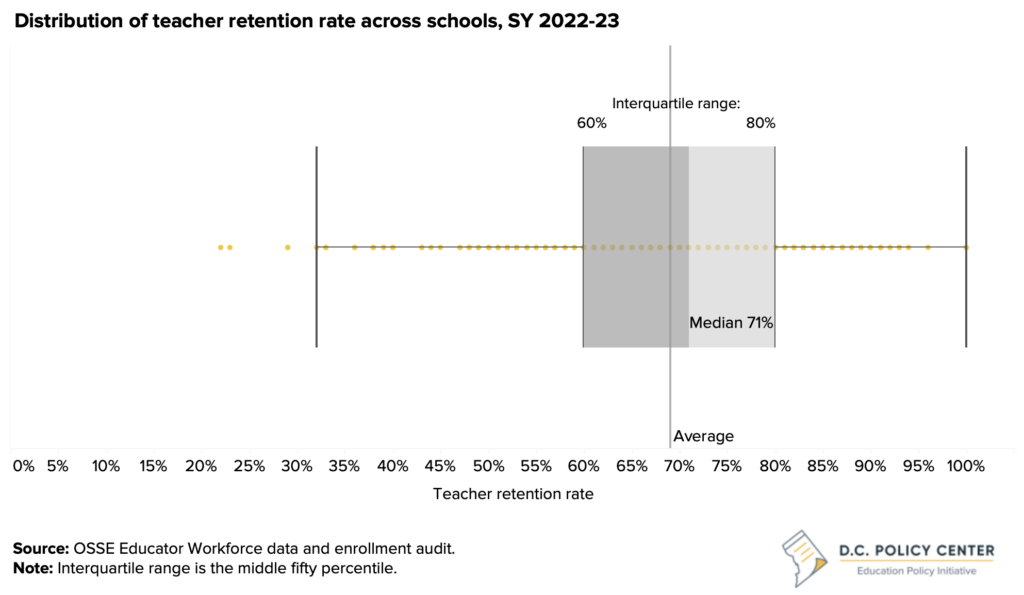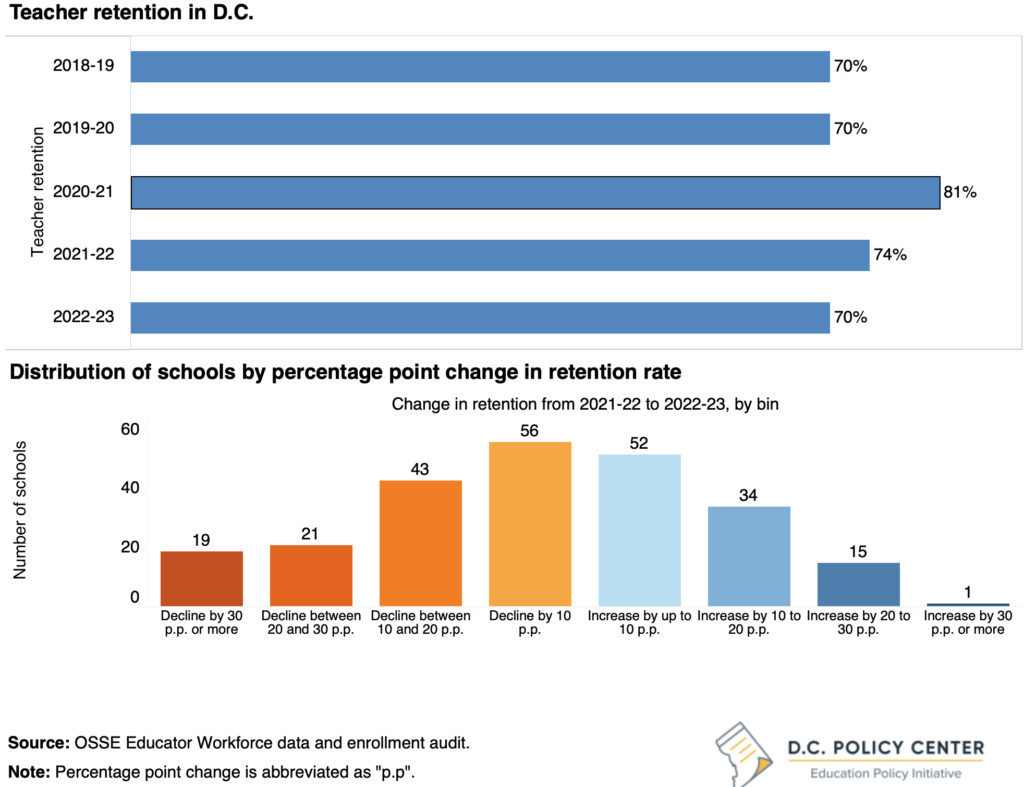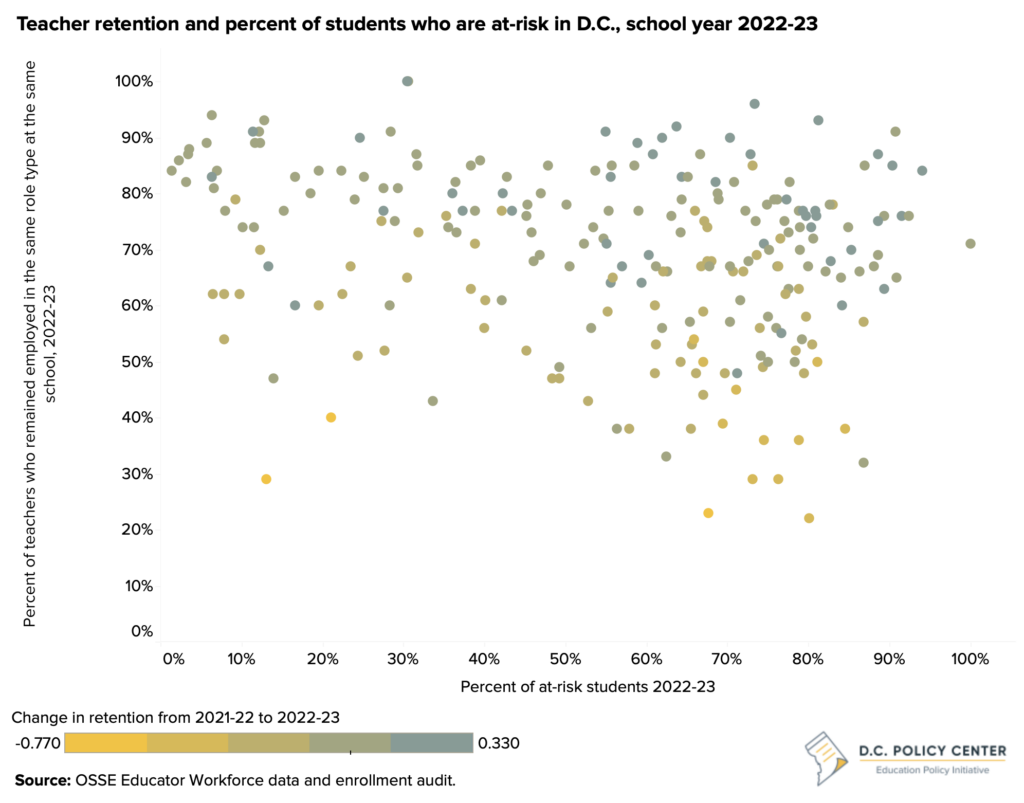

On Wednesday, November 29, 2023, Education Policy Initiative Director Chelsea Coffin testified before the D.C. Council Committee of the Whole, at its public hearing on Teacher and Principal Retention in the District. Her testimony focuses on trends in teacher retention in D.C. You can read her testimony below, or download a PDF copy.
Teacher retention increased during the pandemic, but last year, it declined again, back to pre-pandemic levels. In my testimony, I will share four findings on teacher retention trends and offer some recommendations. My testimony is based on analysis of OSSE educator workforce data for school years 2021-22 and 2022-23 and listening sessions with teachers to inform our upcoming State of D.C. Schools report.
In the fall of 2022, the average school in D.C. retained 70 percent of teachers (defined as staying in the same role as the same school) meaning they had to replace 30 percent of their teachers—a large share.
However, there was a lot of variation: Half the schools experienced retention within 60 to 80 percent, but the experiences varied greatly among other schools: 6 schools managed to retain 90 percent of their teachers, and 3 schools retained under 30 percent only.


Teacher retention in 2022-23 was lower than the previous two school years (81 percent at the peak in 2020-21).
This is likely because fewer teachers changed jobs during the first two years of the pandemic when there was a lot of uncertainty. Average retention decreased by 4 percentage points between 2021-22 and 2022-23. Most schools fell between a decrease of 10 percentage points and an increase of 10 percentage points. But there is a positive story: 50 schools experienced a gain in retention that is higher than 10 percentage points (up to 33 percentage points increase). Out of these schools, 26 with a large gain in retention also had high retention (above 80 percent) in 2022-23.


Student demographics or school leader turnover does not explain the variation in teacher retention across schools.
Retention is not correlated1 with percent of students who are at-risk (which can be negatively associated with retention)2, although it is lower at schools in in Wards 2, 5, 7, and 8—and may suggest that some neighborhood trends may have an impact. And principal retention (which can impact teacher retention)3 at DCPS schools (data were not available for public charter schools) was not associated with teacher retention in school year 2022-23. Ideally, data more for more years is needed to know if this is specific only to these two years of data or longer-term trends.


School approaches may be key to increasing retention.
In D.C. Policy Center listening sessions, teachers mentioned flexibility as key benefit they experienced in their profession during the pandemic. Teachers also enjoyed more autonomy to be creative and engage with their students in highly effective ways.
Teachers highlighted the following challenges as they consider whether to stay in the same school or profession:
- Students’ chronic absenteeism, which is tough for morale and continuity of instruction.
- Understaffing due to some positions going unfilled all year. Schools tried virtual teachers, subs, or teachers covering other classes, which was burdensome.
- Finding a substitute when teachers have to be absent, especially when teachers could not take leave unless they find a sub—and having a dedicated pool of substitutes for a school makes a difference.
D.C. should find out more, and look at the practices of schools that have bucked the retention trend last school year by keeping or increasing their retention.
This is especially important now because it is getting harder to fill empty positions. In particular, D.C. needs to figure out which factors that made retention higher during the pandemic can be replicated (flexible scheduling, autonomy, dedicated subs, other approaches to reduce burnout) and whether the schools with high retention and retention increases were implementing these approaches.
Endnotes
- There is a weak correlation of -0.22 between retention and at-risk percent in school year 2022-23.
- Alderman, C., Goldhaber, D, and Theobald, R. 2021. “Examining the dimensions of Teacher Turnover.” CALDER Policy Brief No. 24-0421. Retrieved from https://caldercenter.org/publications/examining-dimensions-teacher-turnover
- Harbatkin, E. and Henry, G. 2019. “The cascading effects of principal turnover on students and schools.” The Brookings Institution. Retrieved from https://www.brookings.edu/articles/the-cascading-effects-of-principal-turnover-on-students-and-schools/
